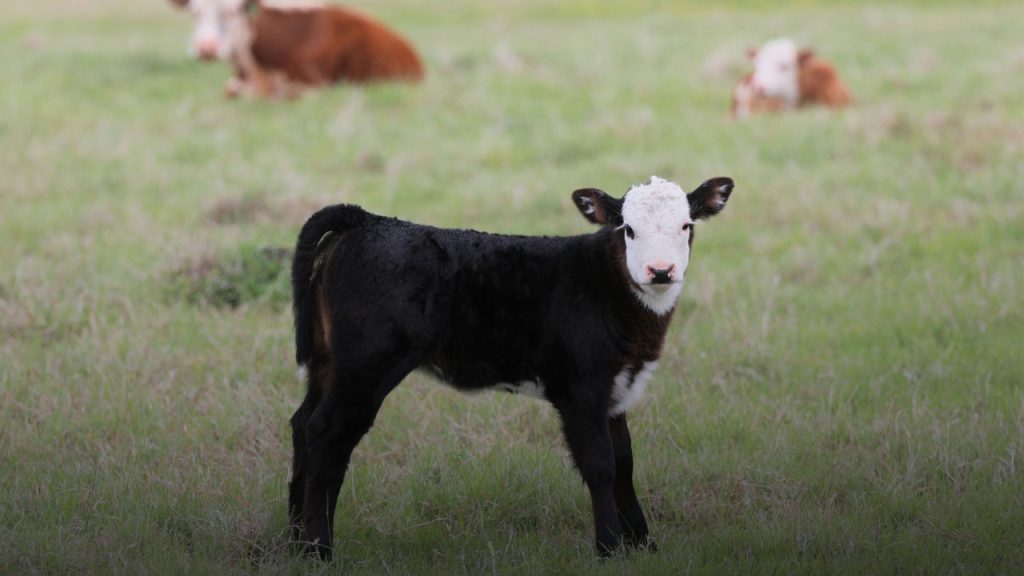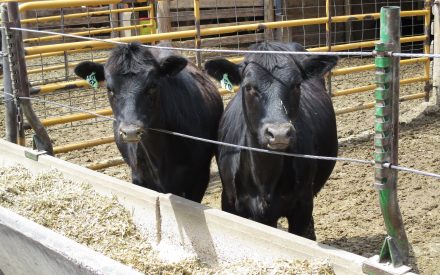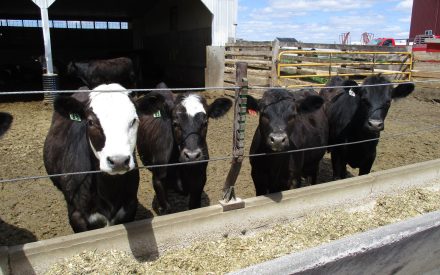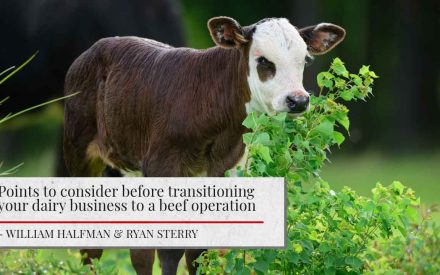
Introduction
Crossbreeding is overlooked as a tool that has many benefits for beef producers to improve herd productivity. A well-planned crossbreeding program leads to improvements in both the calf crop and the lifetime of momma cows compared to straight bred cows.
Heterosis
One of crossbreeding’s primary advantages is heterosis, also called hybrid vigor. Heterosis occurs when different breeds are mated together. The greater diversity in genes between the parents, the greater expression of hybrid vigor which is why this is observed when crossing different breeds rather than unrelated or distantly related animals within a breed. This allows the offspring to perform above their parents’ average in some traits. Traits that have lower heritability will have greater improvements from hybrid vigor than traits that are highly heritable. Table 1 lists example traits and the approximate influence of heterosis. Higher heterosis means greater improvement potential from crossbreeding.
Relationship between Heritability and Heterosis
| Traits | Heritability | Level of Heterosis |
|---|---|---|
| Carcass/end product Skeletal measurements Mature weight | High | Low (0 to 5%) |
| Growth rate Birth weight Weaning weight Yearling weight | Medium | Medium (5 to 10%) |
| Maternal ability Reproduction Health Cow longevity Overall cow productivity | Low | High (10 to 30%) |
(Kirkpatrick, 2017)
Productivity
Crossbred calves will have heavier weaning weights compared to straight-bred calves, resulting in more pounds of calf to sell. However, for the cow-calf producer, the advantages of using crossbred cows are even greater. Research that tracked crossbred cows and straight bred cows found that crossbred cows on average tended to remain productive members of the herd for one year longer than straight bred cows. Cow productivity and longevity are important traits for profitability, especially when it takes the average heifer six calves to become profitable from a lifetime profitability standpoint. That means paying back all her development costs in addition to her annual costs to produce a calf each year.
A Well-planned Approach
A good crossbreeding program means a well-planned approach using breeds that complement each other to produce a uniform calf crop. Randomly selecting different breeds of bulls or cows over time is not a well-planned approach and can be detrimental to the quality and uniformity of the calf crop. There are different approaches to a well thought out plan that can work for producers of all sizes. Maximum heterosis is achieved when three different breeds are used in a planned manner. Using two breeds will result in approximately 67% of the heterosis that the three-breed approach will yield, which is still an improvement.
Crossbreeding Program Examples
Some crossbreeding programs are simple, while others are more complex and require more record keeping to match females to the correct bull breed. For example, a two-breed terminal cross program where heifers are not retained requires minimal tracking. A three-breed program where heifers are retained maximizes the benefits of heterosis, but requires more tracking and planning. A few examples of crossbreed programs include:
- Using artificial insemination to breed cows to complementary breeds. Using an estrous synchronization program and sexed semen can even help get early born heifers as a potential replacement pool.
- Purchasing crossbred replacement heifers of known consistent breeds and using a bull of a third breed.
- Larger herds that use multiple bulls, with a little record keeping, can group cows accordingly and put them out with the breed of bull that will optimize crossbreeding.
- There are plans for small, one bull herds, that want to raise their own replacements using a planned rotation of bull breeds that will result in capturing some hybrid vigor over time.
More examples of crossbreeding programs can be found at: Crossbreeding systems for small herds of beef cattle ↗️
Summary
Crossbreeding is an underutilized tool that can yield positive results for beef cow-calf producers. Evaluate your operation and determine if you can take advantage of what hybrid vigor can do for you.
Authors

William Halfman
Beef Outreach Specialist – Bill’s educational programming has focused on beef cattle production and management, agronomic crops and soils production and management, small scale fresh market and bedding plant production, and specialty crop management.
References
- Cundiff, L.V., and K.E. Gregory. 1999. What is Systematic Crossbreeding? Proc. NCBA Cattleman’s College, Charlotte, NC, February 1999.
- Cundiff, L.V., F. Szabo, K.E. Gregory, R.M. Koch, M.E. Dikeman, and J.D. Crouse. 1993. Breed Comparisons in the Germplasm Evaluation Program at MARC. Proc. Beef Improvement Federation Res. Sym. and Ann. Mtg. pp 124-136.
- Kirkpatrick, D.F., W471 Crossbreeding in Beef Cattle, 2017
https://utbeef.tennessee.edu/wp-content/uploads/sites/127/2020/11/W471.pdf - Lamberson, B, Thomas, J., Crossbreeding Systems for Small Herds of Beef Cattle, 2021, https://extension.missouri.edu/publications/g2040
- Long, C.R., Crossbreeding for Beef Production: Experimental Results. Journal of Animal Science, Volume 51, Issue 5, November 1980, Pages 1197–1223, https://doi.org/10.2527/jas1980.5151197x
Reviewed by:
Beth McIlquam, Kim Kester and Ryan Sterry, Regional Livestock Educators, UW-Madison Division of Extension
The University of Wisconsin–Madison Division of Extension provides equal opportunities in employment and programming in compliance with state and federal law.


 Beef x Dairy Crossbreeding and calf management practices on Wisconsin dairy farms (Part 1)
Beef x Dairy Crossbreeding and calf management practices on Wisconsin dairy farms (Part 1) Beef x Dairy Crossbreeding and calf management practices on Wisconsin dairy farms (Part 2)
Beef x Dairy Crossbreeding and calf management practices on Wisconsin dairy farms (Part 2) Using Genomics as a Decision-Making Tool for Commercial Replacement Heifers
Using Genomics as a Decision-Making Tool for Commercial Replacement Heifers 🎧 LISTEN: Points to consider before transitioning your dairy business to a beef operation
🎧 LISTEN: Points to consider before transitioning your dairy business to a beef operation


